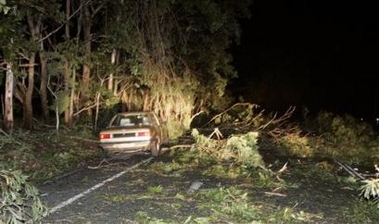CAIRNS, Australia - Metal roofs littered streets, wooden houses lay in
splinters and banana plantations were stripped bare after the most powerful
cyclone to hit Australia in three decades lashed the country's eastern coast
Monday.

A car is seen stuck
under fallen trees on one of the main roads outside Cairns leading to
Innisfail after cyclone Larry swept through the region on Monday, March
20, 2006. The cyclone ripped roofs off buildings across Australia's
northeastern coast packing winds up to 290 kph (180 mph), leaving an
unknown number of people homeless but causing only a handful of minor
injuries. [AP] |
Amazingly, the storm caused no reported fatalities, and only 30 people
suffered minor injuries. But the damage from Cyclone Larry, a Category 5 storm
with winds up to 180 mph, was expected to run into the hundreds of millions of
dollars.
Hardest hit was Innisfail, a farming city of 8,500 people 60 miles south of
the tourist city of Cairns in northeastern Queensland state. By Tuesday the
storm was well inland and downgraded to a severe low pressure system.
"It looks like an atomic bomb hit the place," Innisfail mayor Neil Clarke
told Australian television. "It is severe damage. This is more than a local
disaster, this is a national disaster."
Prime Minister John Howard on Tuesday pledged his administration would help
shattered communities rebuild.
"The federal government will give what is needed to get these communities
back on their feet," Howard said in a radio interview. "We just need a day or
two to make a proper assessment of how the money can best be spent."
Innisfail urgently needs accommodation for people whose homes were damaged, a
power supply to feed hospitals and other infrastructure, Clarke said.
There was no official count of the homeless Monday, but given the number of
homes badly damaged, the figure could run into the thousands, Clarke said.
The casualty toll was so low because people left town or went to shelters
after authorities posted warnings. Residents and officials were mindful of the
damage Hurricane Katrina did to New Orleans and Mississippi last August, said
Ben Creagh, a spokesman for Queensland state Department of Emergency Services.
"Everyone here studied Katrina and took a lot of messages away, a lot of
lessons at the expense of the poor old Yanks," Creagh said. "There was
absolutely no complacency at the planning level at all, and I think that shows.
... Good planning, a bit of luck ¡ª we've dodged a bullet."
Within hours of the storm's landfall, officials declared a state of
emergency, prepared Black Hawk helicopters to run rescue missions and announced
cash payouts for victims ¡ª $720 for each adult and $290 for each child who lost
their home. Prime Minister John Howard indicated more aid was to come.
Queensland Premier Peter Beattie said 55 percent of homes in Innisfail had
been damaged, though rescue teams had yet to get full access to the swamped
region. All roads into the town remained blocked late Monday.
Innisfail Barrier Reef Motel owner Amanda Fitzpatrick echoed the mayor's
damage assessment.
"We could only go out in the eye of the storm and have a look and it just
looks like an atomic bomb has gone off," she told Australian Broadcasting Corp.
radio.
Farmers were expected to be among the hardest hit. The region is a major
growing region for bananas and sugar cane, and vast tracts of the crops were
flattened.
"It looks like someone's gone in there with a slasher and slashed the top off
everything," said Bill Horsford, a cane farmer. One lawmaker estimated lost
revenues could run to $110 million.
The storm also barreled over a portion of Australia's Great Barrier Reef,
damaging a narrow band of coral, said David Wachenfeld, director of science at
the government body that cares for the reef.
The reef is more than 1,240 miles long, and the affected area is only about
30 miles across and far from the places where nearly 2 million tourists a year
gaze in awe at the coral's vibrant colors and fish life, he said.
It would take 10 to 20 years for new coral to grow and replace the damaged
area, he said.
The storm was the most powerful to hit Australia since Christmas Eve 1974,
when Cyclone Tracy destroyed the northern city of Darwin, killing 65 people.
A man who answered the phone at an Innisfail evacuation center late Monday
said it was too soon to estimate the number of people who lost their homes.
"We are trying to collate at the moment how many houses have been destroyed,
how many people we have in shelters," he said. "There are just so many people
and so much damage."